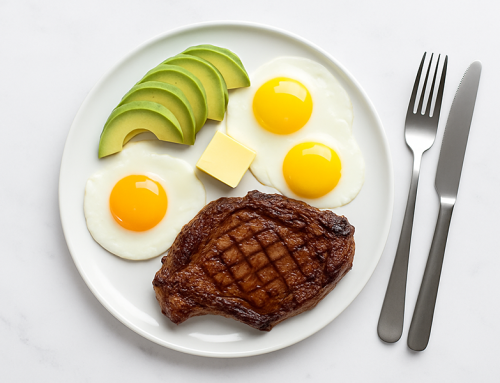Have you ever been told that to lose weight, you should eat low glycemic index (GI) or (supposedly better) low glycemic load (GL) foods? Or, did you ever read that high GI foods are more likely to turn into fat? (Perhaps, because they “spike insulin?”) The truth is, glycemic index (GI) and glycemic load (GL) have no impact on fat loss whatsoever (independent of calories), and this has been proven in at least a half a dozen scientific studies.

Generally healthy people (no problems with blood sugar) don’t need to worry about GI numbers.
In fact, for people who are apparently healthy (not diabetic or struggling with blood sugar disorders), the GI (and GL) are simply distractions that add unnecessary complexity and confusion.
I’ll explain why below, but first, let me briefly explain the GI.
What Is The Glycemic Index (GI)?
The GI is a nutrition tool that was designed to help people determine the effect of individual foods on their blood sugar.
GI scale (usually ranked from 1 to 100) measures how quickly carbohydrate foods are digested, absorbed and transformed into blood sugar. Glucose is the reference food and has a GI of 100. (Which means if a food raised blood sugar even more than pure glucose, it could score even higher than 100).
Foods which are high on the glycemic index (above 70), cause the fastest rise in blood sugar. Foods in the middle (56 to 69) produce a moderate rise in blood sugar. And foods which are low on the glycemic index (55 and under), lead to the slowest rise in blood sugar.
An example is white potatoes, which typically rank around 80, depending on the type and how it’s prepared. This is one of the reasons that people are afraid to eat potatoes (which is unfortunate, as you’ll soon see).
Technically, the GI is not a “diet.” However, I would argue that it has been promoted as a diet, and in a faddish and scientifically inaccurate way. There are in fact books with titles such as, “The Glycemic Index Diet” and the “Glycemic Load Diet.”
Flaws In The GI System
At first glance, it might seem straight-up common sense that GI numbers would be valuable information to have at your fingertips, at least if you’re diabetic or pre-diabetic.
To stay healthy, diabetics need to monitor the effect that specific foods have on their blood sugar, and minimize or avoid foods that throw their glucose levels out of whack.
But some time after this numerical carb-rating system first became popular, we discovered that the GI had major flaws right from the start, even regarding its value for managing blood sugar.
There are limitations in strictly using the GI as your only criteria to choose your foods, and there are major flaws in the concept of low GI eating for weight loss.
The first problem is that the GI is based on eating 50 grams of an individual carbohydrate food – and eating it in a fasted state (that’s how the original GI ratings were determined). When you eat multiple times per day, the GI loses some of it’s significance because you may still be digesting your last meal or snack.
The second issue is that when carbs are eaten in mixed meals that contain protein, fat, and or fiber, the glycemic index loses even more significance because the other foods can slow the absorption of the high GI carbs.
For example, mashed potatoes have a glycemic index near pure glucose, but combine the potatoes with a chicken breast and broccoli and the glycemic index of the entire meal is lower than the potatoes by themselves.
Rice cakes have a very high GI, but if you put a couple tablespoons of peanut butter on them, the fat would slow the absorption of the carbs, thereby lowering the GI of the combination.
Another major limitation of the GI is that some foods which are considered potentially fattening and unhealthy, such as ice cream, peanut M & M’s, and chocolate cake, can actually be low on the GI scale. Just because it’s a low GI food doesn’t mean it’s healthy or nutritious. Using the GI without considering whether a food is processed or calorie-dense can lead to very bad eating decisions.
To confound matters more, even the amount you cook a food can affect the GI. For example, spaghetti boiled 10 minutes could have a GI of 44, but overcooked spaghetti (boiled 20 minutes) could have a GI of 64.
The GI also doesn’t account for the number of grams of carbs, which is what affects blood sugar level the most. If you eat a high GI food, but you eat a tiny portion that doesn’t contain many calories or grams of carbs, that won’t have as much impact on your blood sugar.
Carrots and watermelon for example, have been previously condemned by GI diet followers simply because they’re high on the glycemic index. But these foods are completely natural, unprocessed, and low in carbs / calories per serving compared to many other high GI foods.
Here’s another potential flaw: People who follow the GI system tend to think low GI foods are “good” and that often prompts them to eat more of them. But from a pure weight loss (energy balance) perspective, a metbolizable calorie is a calorie, regardless of the GI, and you can get fat on low GI foods just as easily as high GI foods – and many people do.
Even the staunchest advocates of using the GI system knew the system was flawed, so that prompted the development of the glycemic load (GL), which was supposed to be an improvement over the GI.
The glycemic load was a new scale that did in fact take into consideration both the GI of a food, as well as the number of calories and amount of carbohydrate it contained per serving. Glycemic Load equals GI/100 multiplied by the net grams of planned carbohydrate.
Low GL foods rank 10 or less, medium GL foods 11 – 19, and high GL foods are 20 or higher.
Some people switched from using GI to the GL, believing it was the superior method, or at least they started taking GI alone with a grain of salt. Yet even GL has not proven beneficial for weight loss, even though it might be a better tool for monitoring glycemic response than GI.
Why Glycemic Load And Glycemic Index Diets Won’t Help You Lose Fat
The GI and GL have attracted a lot of attention in the weight loss, fitness, and bodybuilding world and have even become the central theme in numerous best-selling diet books as the primary method for choosing the best foods – not just for health purposes – but also for losing weight.
But losing weight and fixing health problems are two separate goals (even though they obviously overlap, and weight loss usually improves health).
According to advocates of the GI system, foods that are high on the GI scale such as potatoes, as well as rice cakes, carrots, watermelon or grape juice are “unfavorable” and should be avoided because high GI foods are absorbed quickly, raise blood sugar rapidly and therefore, they claim, are more likely to convert to fat.
Instead, you are urged to consume carbohydrates that are lower on the GI scale such as black eye peas, barley, old fashioned oatmeal, peanuts, grapefruit, apples and beans because they do not raise blood sugar as rapidly and therefore, they hypothesize, are less likely to turn into fat.
This may come as a surprise to a lot of people, but a decade and half of research has revealed that choosing low GI or low GL foods alone does not improve weight loss, if your calories stay the same, and all else remains equal.
In controlled trials where researchers match two groups at the same calorie level and feed one group a high GI diet and one group a lower GI diet, the weight loss is virtually identical (see the research list below for evidence).
Two Interesting Case Studies
Advocates of various diet programs sometimes ignore or even criticize the scientific evidence and give more weight to testimonials and their own personal results. That’s each person’s prerogative, misguided as it may be. Ideally, we should look at both – the research and our personal experience – as the ultimate way to make our decisions.
It’s important to remember that for every anecdote claiming success on a diet, there are usually just as many who experienced the opposite. I know many bodybuilders (myself included) who eat high GI foods every day right up until the day of a competition and they reach single digit body fat.
Over a 15-year competitive bodybuilding career, I was consistently able to reduce my body fat to 4-5% or even less on the day of competition. While I would characterize my pre-contest diet as very strict, high in protein and containing virtually no processed food, I did not intentionally avoid high GI foods. In fact, I ate a lot of white potatoes as one of my favorite carb sources.
How do physique athletes get so lean eating potatoes if high GI foods make you fat?- It’s simple – high GI foods DON’T make you fat – an excess of calories makes you fat. If you’re in a calorie deficit, you’ll lose fat on a high potato diet as well as any other diet in a deficit.
Men’s Health magazine recently reported the story of Chris Voigt’s “Potato diet” where he lost 117 pounds in a year eating nothing but potatoes. It’s never recommended to eat only one food (especially when that leads to inadequate protein intake), and this is not science, but this is yet another interesting anecdote / case study demonstrating that foods don’t make you fat, excess calories do.
Although it’s overly simplistic to say that calories are the only thing that matters for fat loss, a calorie deficit is an essential condition for weight loss, so a low GI diet that doesn’t put you in a deficit, won’t work for weight loss.
Why I didn’t include the glycemic index in my program
I recently updated our lists of the best foods for fat loss (as part of the Burn the Fat, Feed the Muscle program), and also updated our online Meal Planner software food data bases.
When I announced these updates to my readers, they appreciated the new food listings and additional data. But quite a few people asked me why I didn’t include the glycemic index of each food. A few even thought it was an oversight that I left it out.
Although knowing the GI and or GL of various foods may be helpful for blood sugar management, my program was not designed for clinical purposes. For everyone else, I believe that including GI and GL lists would just add more layers of unnecessary complexity and confusion.
The simpler you can keep your diet, the better.
For people who need GI information, the data is readily available for free online and anyone with health concerns or clinical issues can (and should) consult their doctor and or a registered dietician/ clinical nutritionist for advice.
What The Newest Research Says (Surprising Revelations About GI And GL)
Today, the research is virtually conclusive on the subject of GI/GL and fat loss. In fact, some of the new research has not only confirmed that low GI and low GL diets are a complete bust for weight loss, it reveals that other health claims were made for GI may also have been wrong.
In 2017, a comprehensive science review said there is no evidence available showing that low GI diets have any effect on preventing cardiovascular disease and there is no convincing evidence that low GI diets have a beneficial effect on blood pressure or blood lipids (at best, research findings are mixed).
A 2014 study from the Journal of the American Medical Association found that under well-controlled conditions, low GI diets did nothing to improve insulin sensitivity, blood lipids, or blood pressure.
And a 2015 study published in the scientific journal, Obesity, confirmed all the previous research about weight loss when it found no metabolic or fat loss advantage of low GI diets over high Gi diets.
The new studies were well-controlled and long enough in duration to allow time to detect meaningful changes (one of them was 22 weeks long). But their real strength lies in the fact that researchers finally figured out what was wrong with the older studies that suggested weight loss benefits of the low GI diet: The majority failed to match the macronutrients between the diets compared.
What I mean is, they might have pitted a low GI diet that was also lower in carbs and higher in protein against a high GI diet that was higher in carbs and lower in protein. That’s an unfair comparison because we know when you match two diets for protein in a study (and in this case for total carbohydrate content), the only thing that makes a difference for fat loss is the number of calories.
In the new research, even the GL did not make any difference in fat loss, if calories were equal.
And basically, outside of its original intended use, the health claims for using the GI as your primary tool to choose foods are are not supported by science.
Why then, is GI still promoted so much for weight loss to this day?
One answer is that if someone takes a diet that was initially developed only to address one specific health benefit and adds, “helps you lose weight” in the marketing, the sales skyrocket. The idea that choosing lower GI foods helps you lose weight is a great “hook” for diet books.
Another possibility is that low carb (and keto) diets have resurged in popularity again. Many advocates of low carb diets believe in the insulin hypothesis of obesity and weight loss. This might lead low carb advocates to presume something like this: eat potatoes –> spike blood sugar –> spike insulin = “bad” (fat gain). This hypothesis, however, does not stand up under scientific scrutiny. If you’re in a calorie deficit, you will lose weight even if you’re eating high carb, high glycemic foods.
What about people who go on a (low) GI diet and lose weight? Sure that happens, but there’s a logical explanation.
For one thing, when most people start a new diet, they were previously eating like crap, so almost anything is an improvement. Any diet that reduces processed food is likely to reduce calorie intake and result in weight loss. The error is assuming low GI foods were responsible for the weight loss rather than the lower calories.
A diet of low GI foods would make you gain fat if the calories were in a surplus.
If someone goes on a low GI diet and the changes they make in their eating are an improvement over what they were doing before, and this leads to consuming fewer calories, they lose weight. No harm done physically, only benefit. The harm is mental – they believe it worked for the wrong reason… they keep believing in myths.
If lower GI foods were more filling or suppressed the appetite, that could also explain a lower total calorie intake and improved fat loss.However, even that idea has been challenged. One of the newer studies from Cambridge tested low GI diets and found no benefit for satiety or reducing appetite. A truly ironic twist is the fact that white potatoes rank higher on the satiety index than any other food.
There may not be anything inherently wrong with following a low GI or low GL diet, and it might help some people lose weight and get healthier. But it’s not because of those numbers on the GI or GL scales. If a GI diet helps, it’s because for one reason or another it gets you eating less and gets you eating healthier, less processed foods. That’s what you should focus on.
The most important way to make food choices is to ask yourself this question: Is the food processed or unprocessed? Choose fewer processed foods, choose more unprocessed foods, get plenty of fiber, make sure you eat adequate protein, and keep your portion sizes in line with your calorie needs, and you’ve got your bases covered – both for fat loss and for many health issues.
– Tom Venuto,
Author of Burn The Fat, Feed the Muscle.
Founder & CEO, Burn The Fat Inner Circle
PS.Additional Fat Loss Resources:
Burn the Fat, Feed the Muscle is the classic bible of fat loss – a best seller since 2002 – and now available in a new updated version, including audiobook format: https://amzn.to/2Q804R9
Burn the Fat Inner Circle is our tribe of fitness goal achievers – an online fat loss support community and training / nutrition education center for motivation, inspiration and transformation: www.BurnTheFatInnerCircle.com
Scientific References
Aston, LM, et al. No effect of a diet with a reduced glycaemic index on satiety, energy intake and body weight in overweight and obese women. International Journal of Obesity. January 2008. Vol 32. pp 160-165. Human Nutrition Research, Cambridge, UK
Clar C et al, Low glycemic index diets for the prevention of cardiovascular disease, Cochrane reviews, 31:7, July 2017
Diaz EO, et al, Glycaemic index effects on fuel partitioning in humans. Obes Rev. 20067(2):219-26.
Karl JP et al, Effects of carbohydrate quantity and glycemic index on resting metabolic rate and body composition during weight loss, Obesity, 23:11, 2190-2198, 2015
Philippou E et al, The effect of dietary glycemic index on weight maintenance in overweight subjects: a pilot study. Obesity (Silver Spring). 2009 Feb;17(2):396-401.
Raben, A, Should obese patients be counseled to follow a low-glycaemic index diet? No. Obes Rev. 2002 Nov;3(4):245-56.
Raatz SK, et al, Reduced glycemic index and glycemic load diets do not increase the effects of energy restriction on weight loss and insulin sensitivity in obese men and women. J Nutr. 2005 Oct;135(10):2387-91.
Sacks FM et al, Effects of high vs low glycemic index of dietary carbohydrate on cardiovascular disease risk factors on insulin sensitivity; the OminCarb randomized clinical trial. Journal of the American Medical Association, 321:23, 2531-2541, 2014.
Sloth B, et al, No difference in body weight decrease between a low-glycemic-index and a high-glycemic-index diet but reduced LDL cholesterol after 10-wk ad libitum intake of the low-glycemic-index diet. American Journal of Clinical Nutrition, 80:2, 2004.






Do you agree with this information: lifehealthhq.com/intermittent-fasting-pros-cons/
So basically you can have those potatoes and don’t have to worry so much about macros because you eat wit an 8 hour window allowing your body to burn fat.
Also what do you think about alternating hi fat/low carb days with moderate carb, moderate fat days for faster fat loss?
I didnt read the article but people who choose intermittent fasting are still subject to the same laws of energy balance as everyone else – there is absolutely nothing magical about time-restricted eating; the primary benefit is that it is an alternative way that helps some people achieve their calorie deficit. (when you implement a rule that restricts your feeding period to a smaller number of hours, many people will automatically eat less, as long as it doesn’t backfire due to hunger, etc).
Beyond that, i find IF over hyped and over rated (its the current top trending diet… not long ago it was gluten free, then wheat free, then paleo, then keto, now fasting). You always need to be concerned with your calories/macros, regardless which diet you choose and regardless of your meal timing or frequency.
Theres little evidence that alternating macros alone will help with fat loss. If calories remain the same and if protein remains the same, fat loss is likely to be the same. What may happen is some people who set a rule to eat fewer carbs on some days, DO end up eating fewer calories, and the reduction in calories is where the added fat loss came from, not from the change in macro ratios itself.
What May very well help over the long term is cyclical dieting where not just macros, but calories vary. Taking higher calorie days, which may come in the form of more carbs (carb cycling) may help, and what may help even more is taking periodic diet breaks up at maintenance calories (“diet breaks”).
Once again its still up to energy balance…..As a rebuttal to Morgan Spurloks “Supersize Me” where Bio teacher John Cisna lostlost 60lbs eating only Mc Donalds and improved his blood work….The caveat being he was restricted to 2000 cals a day and his students had to balance both his micro and macronutrients.
The GI was created for those like myself, with Metabolic Syndrome….When these individuals eat high GI foods the resultant insulin roller coaster wreaks havoc with appetite. Give me a pan of home made Foccacia….I will eat the whole damn thing…Its like a drug!
Also there is the observation that many high GI food are processed…which bring alot of other dietary nastiness into the equation.
Give me a pan of home made Foccacia… and I will eat the whole damn thing too! :-)
I deliver ….. lemme know when you want to carb up! Lol!